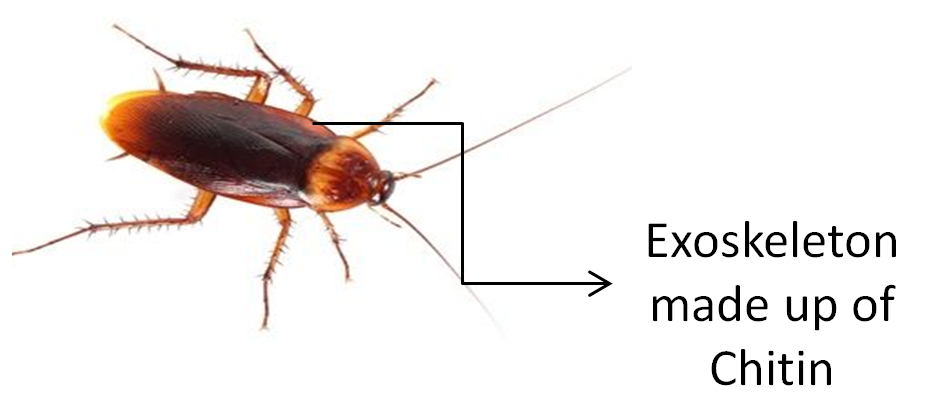
Exoskeleton of cockroach is made up of
(a) Cartilage
(b) Cuticle
(c) Chitin
(d) Amino acid
Answer
500.1k+ views
Hint: The exoskeleton of cockroach is made up of the same material which is present in the cell wall of the fungus.
Complete answer:
The exoskeleton of a cockroach is made up of chitin. The skeleton of cockroach is covered by thick hard chitinous cuticles secreted by the epidermis. Chitinous cuticle which is made up of acetyl glucosamine.

- Chitin is a derivative of glucose, a long polymer of N-acetylglucosamine.
- Chitin is cellulose with one hydroxyl group on each monomer replaced with an acetyl amine group.
- Each monomer of chitin is linked by β (1
- On treating the sterilized skeletal tissue of an insect with concentrated KOH at 160˚ C, the contained chitin is converted to chitosan.
- The percent distribution of chitin expressed as chitosan in the exoskeleton of cockroach is ̴37% in the dorsal abdomen and ̴ 18 % in hindwings.
- An exoskeleton of cockroach along with chitin which supplies the tensile strength is present with other minerals provides hardness and resistance to compression like calcium carbonate is also deposited with some protein molecules. So, the correct answer is “chitin”.
- The presence of chitin in exoskeleton supports and protects the cuticles of the epidermis and trachea as well as.
- Exoskeleton can’t grow because of the chitin present thus, cockroach sheds its exoskeleton several times in the year.
So, the correct answer is, ‘chintin.’
Note:
- Cockroach belongs to Kingdom Animalia; Phylum Arthropoda and Class Insecta.
- The common scientific name of cockroach is Periplaneta Americana.
- The cockroach has three pairs of legs attached to the thorax and has three joints in each leg.
- Chitin is present in the cell wall of fungi and exoskeletons of arthropods.
- The structure of chitin is similar to polysaccharide cellulose.
Complete answer:
The exoskeleton of a cockroach is made up of chitin. The skeleton of cockroach is covered by thick hard chitinous cuticles secreted by the epidermis. Chitinous cuticle which is made up of acetyl glucosamine.

- Chitin is a derivative of glucose, a long polymer of N-acetylglucosamine.
- Chitin is cellulose with one hydroxyl group on each monomer replaced with an acetyl amine group.
- Each monomer of chitin is linked by β (1
- On treating the sterilized skeletal tissue of an insect with concentrated KOH at 160˚ C, the contained chitin is converted to chitosan.
- The percent distribution of chitin expressed as chitosan in the exoskeleton of cockroach is ̴37% in the dorsal abdomen and ̴ 18 % in hindwings.
- An exoskeleton of cockroach along with chitin which supplies the tensile strength is present with other minerals provides hardness and resistance to compression like calcium carbonate is also deposited with some protein molecules. So, the correct answer is “chitin”.
- The presence of chitin in exoskeleton supports and protects the cuticles of the epidermis and trachea as well as.
- Exoskeleton can’t grow because of the chitin present thus, cockroach sheds its exoskeleton several times in the year.
So, the correct answer is, ‘chintin.’
Note:
- Cockroach belongs to Kingdom Animalia; Phylum Arthropoda and Class Insecta.
- The common scientific name of cockroach is Periplaneta Americana.
- The cockroach has three pairs of legs attached to the thorax and has three joints in each leg.
- Chitin is present in the cell wall of fungi and exoskeletons of arthropods.
- The structure of chitin is similar to polysaccharide cellulose.
Recently Updated Pages
Master Class 11 Economics: Engaging Questions & Answers for Success

Master Class 11 Business Studies: Engaging Questions & Answers for Success

Master Class 11 Accountancy: Engaging Questions & Answers for Success

Master Class 11 English: Engaging Questions & Answers for Success

Master Class 11 Computer Science: Engaging Questions & Answers for Success

Master Class 11 Maths: Engaging Questions & Answers for Success

Trending doubts
State and prove Bernoullis theorem class 11 physics CBSE

1 ton equals to A 100 kg B 1000 kg C 10 kg D 10000 class 11 physics CBSE

State the laws of reflection of light

One Metric ton is equal to kg A 10000 B 1000 C 100 class 11 physics CBSE

1 Quintal is equal to a 110 kg b 10 kg c 100kg d 1000 class 11 physics CBSE

Difference Between Prokaryotic Cells and Eukaryotic Cells




